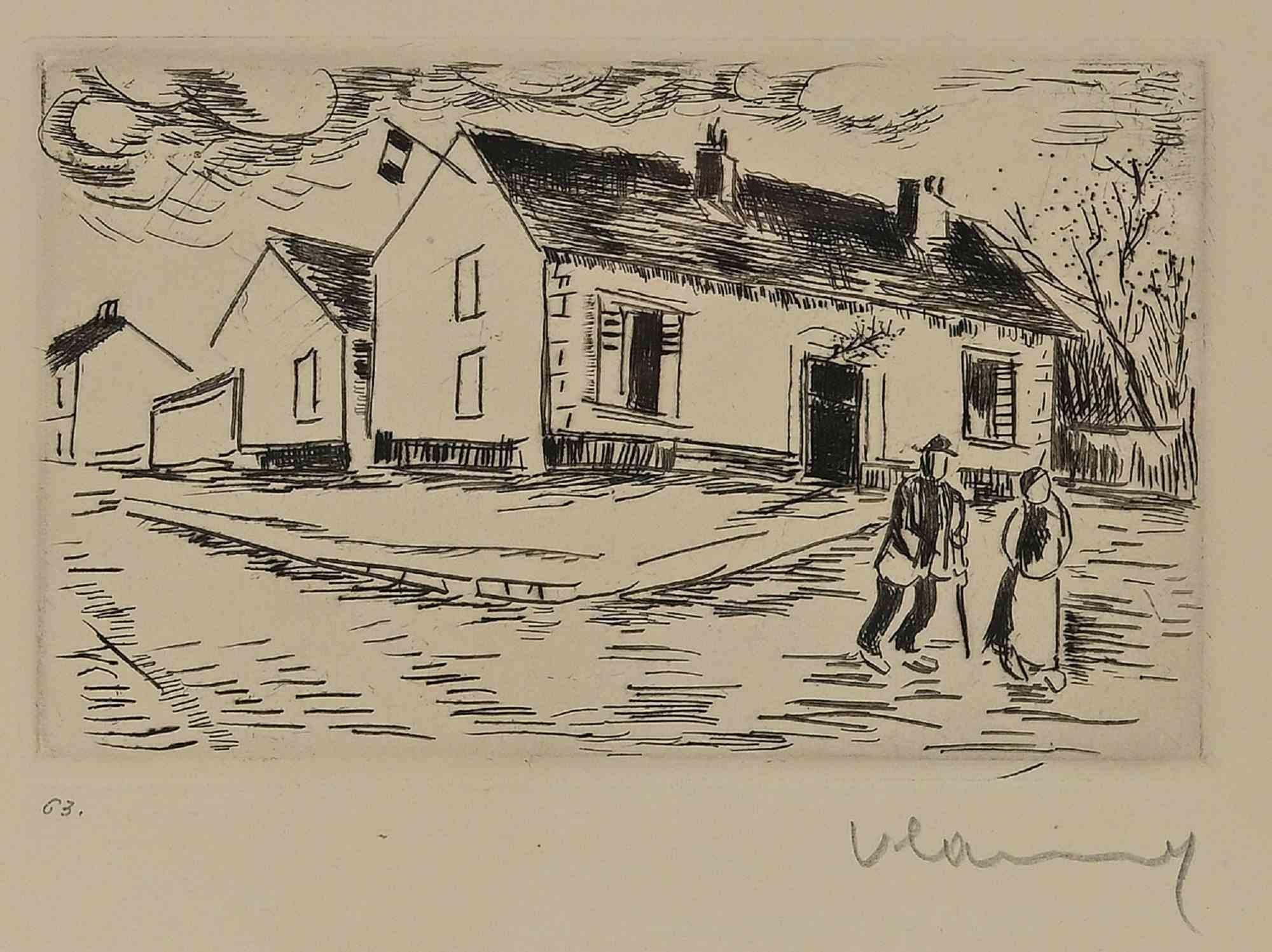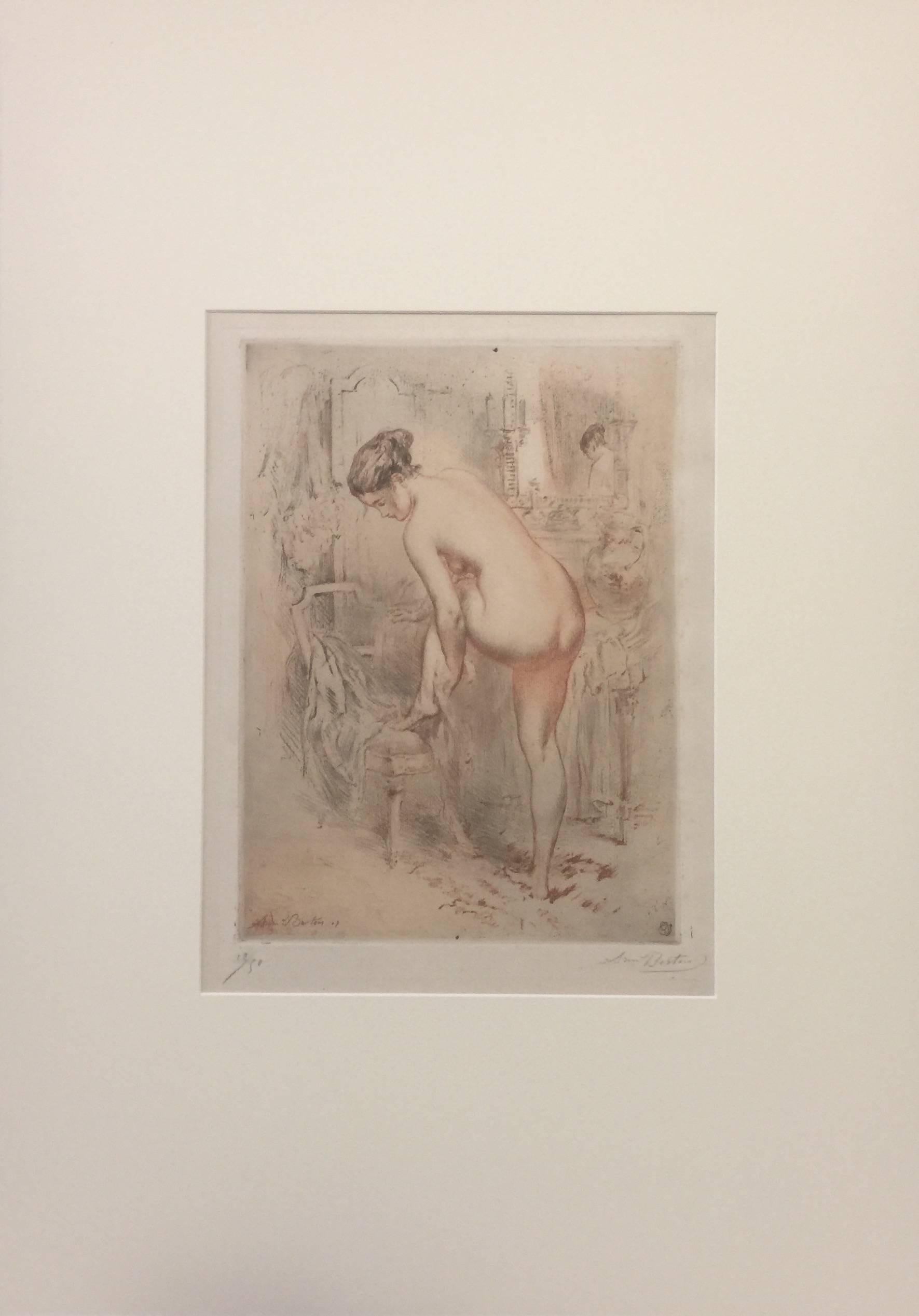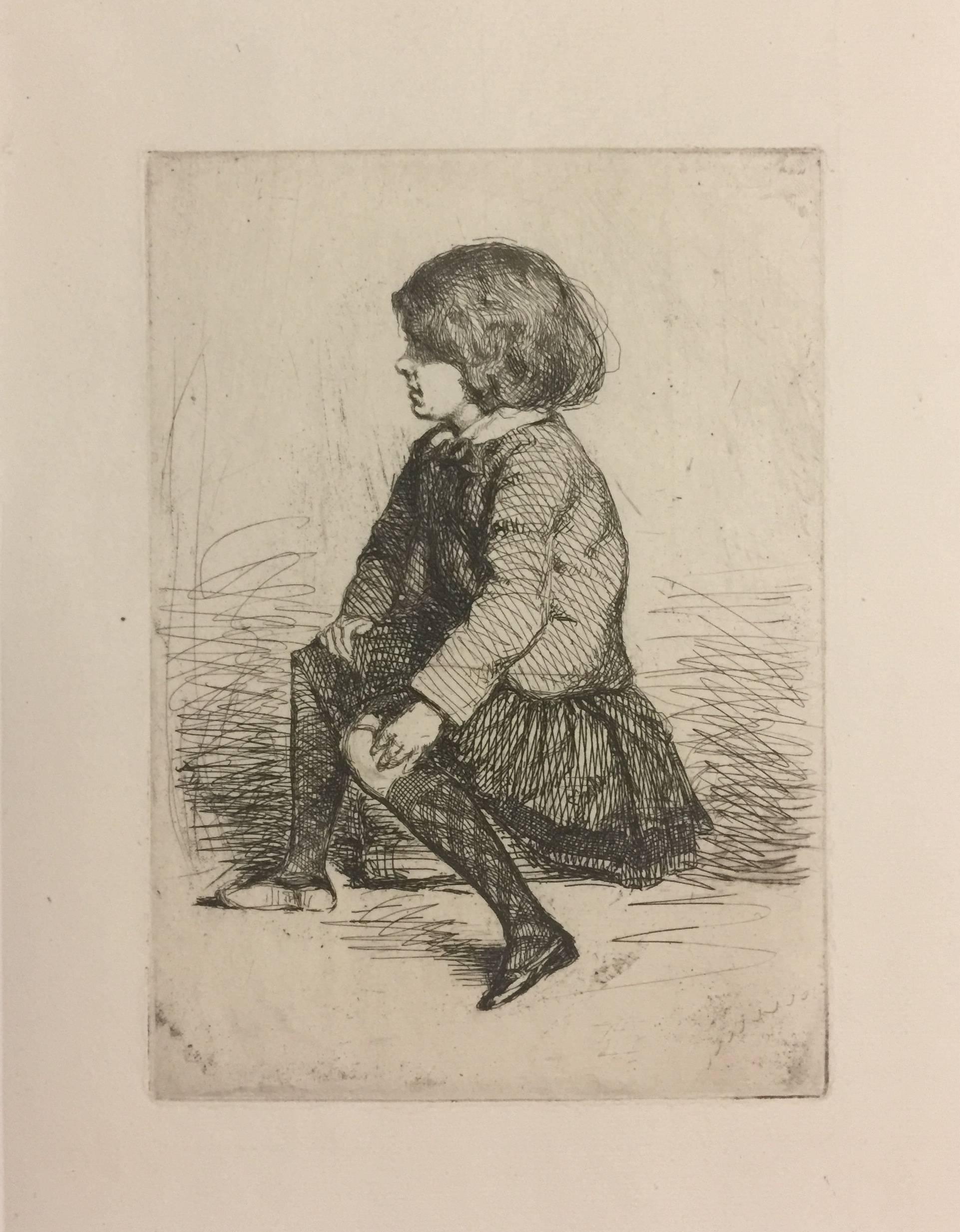Items Similar to Chaumière à Cantepie (Calvados), Etching by Paulémile Pissarro
Want more images or videos?
Request additional images or videos from the seller
1 of 3
Paulémile PissarroChaumière à Cantepie (Calvados), Etching by Paulémile Pissarro
About the Item
SOLD UNFRAMED
Chaumière à Cantepie (Calvados) by Paulémile Pissarro (1884-1972)
Etching
19.5 x 24.3 cm (7 ⅝ x 9 ⅝ inches)
Signed Paulémile-Pissarro, numbered 38/50 and titled lower left; signed again lower right
This work is sold UNFRAMED
Provenance
Private Collection, London
Artist biography
Paulémile Pissarro, Camille Pissarro’s youngest son, was born in Éragny in 1884 where he was brought up within the creatively fertile environment of his family home and, encouraged by his father, began drawing at an early age. Paulémile’s godfather was Claude Monet, who became his teacher and legal guardian after Camille’s death in 1903.
In 1905 Paulémile exhibited at the Salon des Indépendants for the first time. Although his father had supported Paulémile’s desire to be an artist, his mother was eager for him to learn a more practical trade. Therefore in 1908 he put aside his artistic pursuits to work as an automobile mechanic and test-driver, then later as a lace and textile designer, allowing him only a limited time to paint. Paulémile only fully dedicated himself to painting following a letter from his brother Lucien in London, who wrote to invite him to take part in an exhibition held in London. Subsequent to the successful sale of a number of watercolours he had sent over, the young artist became inspired to leave the textile factory and pursue a career in art.
By the 1920s Paulémile had become an established Post-Impressionist artist in his own right, spending the summer months escaping from Paris on painting trips with fellow artists Kees Van Dongen, Raoul Dufy, Maurice de Vlaminck and André Dunoyer de Segonzac. In 1922 Paulémile purchased a house in Lyons-la-Forêt, a small village within the region of his hometown of Éragny and Giverny, where he moved in with his first wife Berthe Bennaiche. During this time, he developed a form of Cubism inspired by Paul Cézanne whom he dearly admired, creating some wonderful paintings of the river Eure and its surrounding villages. There he formed a close friendship with his neighbour, the famous Art Deco designer Émile-Jacques Ruhlmann, who designed a stunning Art Deco studio for Paulémile adjacent to his house.
In 1930 he visited and fell in love with the Swiss Normandy area in the Calvados region, in particular the River Orne which runs through the valley adjacent to the villages of Clécy and St. Remy. The combination of rolling hills, bold meadows and the calm river weaving its way through the landscape offered Paulémile a new burst of inspiration. With his second wife Yvonne Beaupel, Paulémile eventually moved to Clécy in 1935, where he would remain for the rest of his life. Of their three children, both H. Claude and Yvon also became artists.
With his house backing on to the river Orne, Paulémile developed a new way of working using a boat as a floating studio, where he spent countless days painting the calm waters from between the riverbanks. Here the influence of his godfather Claude Monet became apparent, particularly in Paulémile’s depiction of water, which was revolutionised by the Impressionist icon. He also applied Monet’s lessons in horticulture to the creation of an abundant garden, offering him many more motifs for his new paintings. Alongside these river landscapes, he also painted the neighbouring hay fields, various snow scenes, some interiors and still lives. The most ambitious work in his oeuvre was a fresco painted on all four walls of his own dining room, depicting the adjacent river in which he includes family members, neighbours and friends.
In 1967 Paulémile had his first one-man show in the United States at Wally Findlay Galleries in New York. This led to widespread recognition and a degree of professional success that few Pissarro artists knew during their lifetime. Since his death in 1972, Paulémile remains one of the best known of Camille’s sons.
- Creator:Paulémile Pissarro (1884 - 1972, French)
- Dimensions:Height: 7.68 in (19.5 cm)Width: 9.57 in (24.3 cm)
- Medium:
- Movement & Style:
- Period:
- Condition:
- Gallery Location:London, GB
- Reference Number:1stDibs: LU261213961042
About the Seller
5.0
Recognized Seller
These prestigious sellers are industry leaders and represent the highest echelon for item quality and design.
Gold Seller
These expertly vetted sellers are highly rated and consistently exceed customer expectations.
Established in 1964
1stDibs seller since 2015
95 sales on 1stDibs
Typical response time: 8 hours
Associations
Society Of London Art Dealers
- ShippingRetrieving quote...Ships From: London, United Kingdom
- Return PolicyA return for this item may be initiated within 7 days of delivery.
More From This SellerView All
- Charlotte and Amalia by Lélia Pissarro - EtchingBy Lelia PissarroLocated in London, GBCharlotte and Amalia by Lélia Pissarro (b. 1963) Etching 22.7 x 27.5 cm (9 x 10 ⁷/₈ inches) Signed lower left, Lélia Pissarro Numbered lower right, 2/15 Artist biography: Born in P...Category
1990s Post-Impressionist Figurative Prints
MaterialsEtching
- Chatter by Orovida Pissarro - EtchingBy Orovida PissarroLocated in London, GBChatter by Orovida Pissarro (1893-1968) Etching 26 x 19 cm (10 ¹/₄ x 7 ¹/₂ inches) Signed and dated lower right Orovida 1927 Inscribed lower left Trial proof no. 18/25 and titled lower middle Artist biography: Orovida Camille Pissarro, Lucien and Esther Pissarro’s only child, was the first woman in the Pissarro family as well as the first of her generation to become an artist. Born in Epping, England in 1893, she lived and worked predominantly in London where she became a prominent member of several British arts clubs and societies. She first learned to paint in the Impressionist style of her father, but after a brief period of formal study with Walter Sickert in 1913 she renounced formal art schooling. Throughout her career, Orovida always remained outside of any mainstream British art movements. Much to Lucien's disappointment she soon turned away from naturalistic painting and developed her own unusual style combining elements of Japanese, Chinese, Persian and Indian art. Her rejection of Impressionism, which for the Pissarro family had become a way of life, together with the simultaneous decision to drop her famous last name and simply use Orovida as a ‘nom de peintre’, reflected a deep desire for independence and distance from the weight of the family legacy. Orovida's most distinctive and notable works were produced from the period of 1919 to 1939 using her own homemade egg tempera applied in thin, delicate washes to silk, linen or paper and sometimes embellished with brocade borders. These elegant and richly decorative works generally depict Eastern, Asian and African subjects, such as Mongolian horse...Category
1920s Post-Impressionist Figurative Prints
MaterialsEtching
- Man & Beast by Orovida Pissarro - EtchingBy Orovida PissarroLocated in London, GB*UK BUYERS WILL PAY AN ADDITIONAL 20% VAT ON TOP OF THE ABOVE PRICE Man & Beast by Orovida Pissarro (1893-1968) Etching 27 x 22 cm (10 ⁵/₈ x 8 ⁵/₈ inches) Signed and dated lower right, orovida 1924 Inscribed lower left, Final state no 12/40 and titled lower centre Artist biography: Orovida Camille Pissarro, Lucien and Esther Pissarro’s only child, was the first woman in the Pissarro family as well as the first of her generation to become an artist. Born in Epping, England in 1893, she lived and worked predominantly in London where she became a prominent member of several British arts clubs and societies. She first learned to paint in the Impressionist style of her father, but after a brief period of formal study with Walter Sickert in 1913 she renounced formal art schooling. Throughout her career, Orovida always remained outside of any mainstream British art movements. Much to Lucien's disappointment she soon turned away from naturalistic painting and developed her own unusual style combining elements of Japanese, Chinese, Persian and Indian art. Her rejection of Impressionism, which for the Pissarro family had become a way of life, together with the simultaneous decision to drop her famous last name and simply use Orovida as a ‘nom de peintre’, reflected a deep desire for independence and distance from the weight of the family legacy. Orovida's most distinctive and notable works were produced from the period of 1919 to 1939 using her own homemade egg tempera applied in thin, delicate washes to silk, linen or paper and sometimes embellished with brocade borders. These elegant and richly decorative works generally depict Eastern, Asian and African subjects, such as Mongolian horse...Category
1920s Post-Impressionist Animal Prints
MaterialsEtching
- Curves by Orovida Pissarro, 1919 - Etching PrintBy Orovida PissarroLocated in London, GBCurves by Orovida Pissarro (1893 - 1968) Etching, trial proof no. 54 20.2 x 15 cm (8 x 5 ⅞ inches) Signed and dated lower right, Orovida 1919 Inscribed lower left Trial proof no. 54 ...Category
1910s Post-Impressionist Animal Prints
MaterialsPaper, Etching
- Horse Pulling Hay Cart by Félix Pissarro - Animal etchingBy Félix PissarroLocated in London, GBHorse Pulling Hay Cart by Félix Pissarro (1874-1897) Etching 19.5 x 15 cm (7 ⅝ x 5 ⅞ inches) Exhibition London, Stern Pissarro Gallery, Camille Pissarro & hi...Category
1890s Post-Impressionist Animal Prints
MaterialsEtching
- Rupert Rides by Orovida Pissarro - Animal etchingBy Orovida PissarroLocated in London, GB*UK BUYERS WILL PAY AN ADDITIONAL 20% VAT ON TOP OF THE ABOVE PRICE Rupert Rides by Orovida Pissarro (1893-1968) Etching 31 x 23.5 cm (12 ¼ x 9 ¼ inches) Signed and dated lower righ...Category
1950s Post-Impressionist Animal Prints
MaterialsEtching
You May Also Like
- Head of a Young Boy - Original Etching, 1946By Henri MatisseLocated in Paris, FRHenri Matisse Head of a Young Boy, 1946 Original etching Printed signature in the plate On BFK Rives vellum, 33 x 25 cm (c. 12,9 x 9,8 inch) Edition limited to 300 copies (unnumbere...Category
1940s Fauvist Figurative Prints
MaterialsEtching
- Village - Etching by M. de Vlaminck - 1950By Maurice de VlaminckLocated in Roma, ITVillage is a modern artwork realized by Maurice de Vlaminck in 1950. Black and white etching. Hand signed and dated on the lower margin. Edition of 100 specimen as reported on th...Category
1950s Post-Impressionist Landscape Prints
MaterialsEtching
- La ToiletteBy Armand BretonLocated in Roma, ITHand signed. Edition of 50 prints.Original Prints. Image Dimensions : 31 x 23 cm Passepartout included : 69 x 49 cm This artwork is shipped from Italy. Under existing legislation, a...Category
Early 1900s Post-Impressionist Figurative Prints
MaterialsEtching
- Cowdray Castle (with cows)By Sir Francis Seymour Haden, R.A.Located in Roma, ITBeautiful proof on verge, with note “Pl.194” and signed by the artist in pencil. Full margins. Ex-coll. H.H. Benedict (Lugt 1298), with dry stamp not identified. Ref. Cat. Harrington...Category
1880s Post-Impressionist Landscape Prints
MaterialsDrypoint, Etching
- Seymour seatedBy James Abbott McNeill WhistlerLocated in Roma, ITNot signed. The American artist James Abbott McNeill Whistler can be considered a forerunner of the Post-Impressionist movement. Passepartout included : 53 x 37 cm Image Dimensions ...Category
Late 19th Century Post-Impressionist Figurative Prints
MaterialsEtching
- Group of three Clowns - Etching and Drypoint by Jean Lurçat - 1921By Jean LurçatLocated in Roma, ITHand Signed and signed on plate. Edition of 35 prints. Image Dimensions : 30 x 20 cm This artwork is shipped from Italy. Under existing legislation, any artwork in Italy created ove...Category
1920s Post-Impressionist Landscape Prints
MaterialsDrypoint, Etching
Recently Viewed
View AllMore Ways To Browse
Lace Print
De Maneer Etchings
Art Deco Etching
Etching Young Man
Boat Etchings
Monet Signed Prints
La Foret
Cubism Still Life 20th Century
Love Letter Vintage
Pissarro Etching
Prints Claude Monet
Cezanne Etching
Maurice Jacque
Camille Pissarro Etching
Automobile Wall Art
Art Deco Rolling
Andre De Segonzac
Andre Dunoyer De Segonzac




